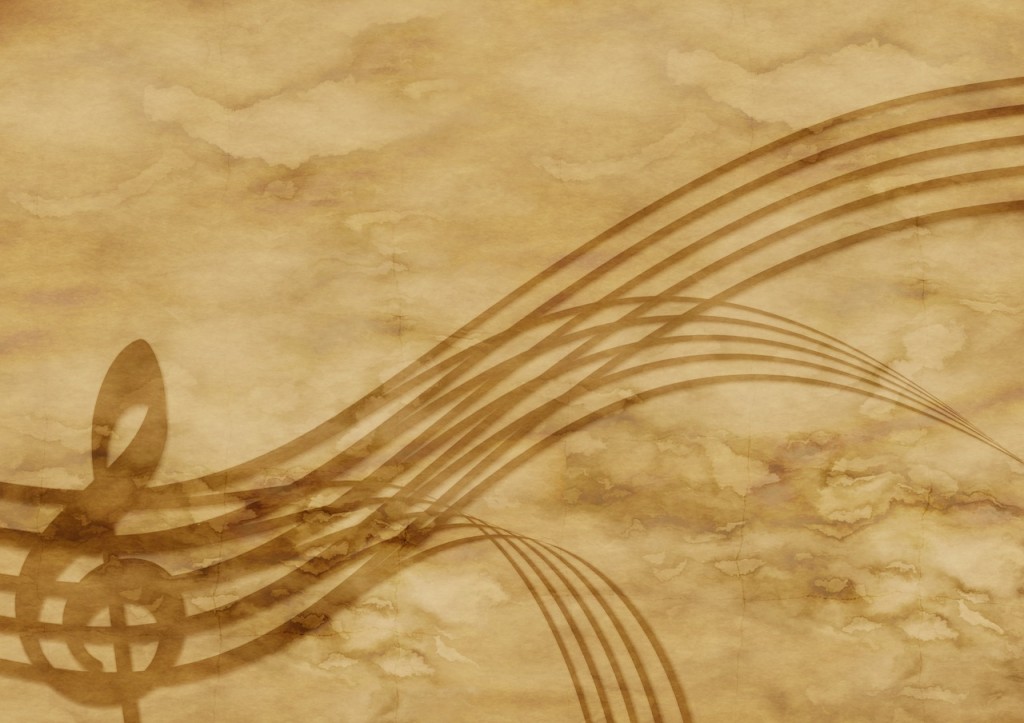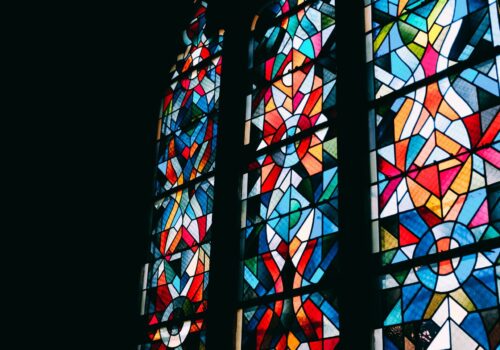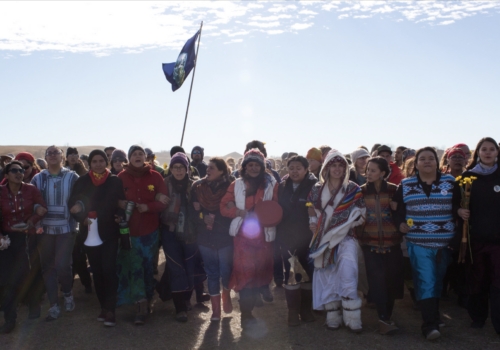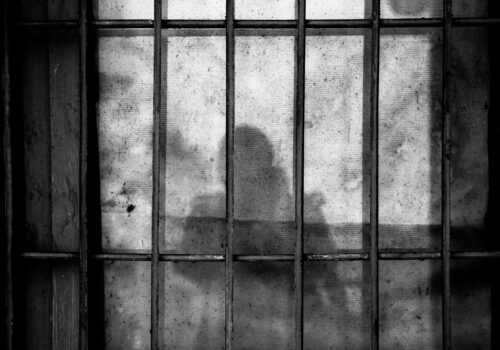Download PDF: Liu, Music and the Generosity of God
Abstract
4’33” by John Cage tacitly combines theory and practice to promote wide attention to music. Although theologically dismissed, the piece also provides an acoustical opening to recognize that all sounds radiate the generosity of God. The article below retrieves the composition in order to propose that the giving of God manifests in the ubiquitous soundscapes of ordinary life. Furthermore, the soundscapes of everyday life constitute particular kinds of theological proclamation and invitations to worship. By linking historical influences of 4’33” – an arts symposium at Vassar College, two lectures at Julliard and Wesleyan University based upon the teachings of Daisetsu Teitaro Suzuki, and the White Paintings by Robert Rauschenberg – with Jean-Luc Marion’s concept of “givenness,” the essay suggests that Divine generosity reverberates in music without boundary. As illustration, the final pages briefly sketch how communion and the life it celebrates and the life of which it is a part vocalize the
nearness of God.
Sonic Ubiquity and Divine Charity
In 1872, Nietzsche described music as that which is “the direct copy of the will itself, and therefore represents the metaphysical of everything physical in the world, and the thing-in-itself of every phenomenon.”[1] In other words, music amplifies the essence of all that we can experience and know, but only by first echoing human freedom and power.[2] Eighty years later, on August 29, 1952 American composer John Cage’s 4’33” (four thirty-three) seemed to exemplify exactly what Nietzsche meant.[3] In actuality, the composition announced far more – the ubiquity of music and the generosity of God. Music is a staple in millions upon millions of people’s lives, there is no limit to what music can do and be. Websites such as Hooligan RocknRoll discuss and inform lovers of music about what is currently happening in the industry and the effect of music, which can be a great addition to the ongoing conversation in the world.
The ubiquity of music expresses a material idea that music appears everywhere sound occurs (which is scientifically-proven to be every place). Music pronounces itself without boundary or necessary genesis in human intent. 4’33” draws attention to the ubiquity of music with especial clarity.
God in the following pages describes the one who biblically self identifies as Ehyeh asher Ehyeh (I will be what I will be) and the one biblically portrayed as creator and giver of all times, places, persons, and things, including sounds. For the current author, God lived on the earth as Jesus of Nazareth, gifted humanity with the Holy Spirit, and will come again to judge and to redeem the totality of life. Yet in as much as God may be known by theological discourse and concepts like “Creator,” “Savior,” “Redeemer” and “Trinity,” God is beyond Being, even in the supreme sense, and remains forever undefined by human, biblical, and/or doctrinal description or any other kind of articulation. Only God fully defines God.
Yet God’s own disclosure is not the only way in which the incomprehensible God imagined here becomes knowable. Intimating God also becomes possible according to what God furnishes in everyday existence – by what God gives. The essay here proposes that music, broadly conceived according to the ubiquity of sound, constitutes one aspect of divine generosity. Music is not God but music is given by God. If you enjoy music take a look at the graham slee hifi store to see how the right equipment could transform your listening experience. No wonder people use these with Multi-room audio system.
Maverick Hall
At an outdoor amphitheater located in the Woodstock Valley of New York’s Catskill Mountains, Maverick Hall, pianist David Tudor sat down for his penultimate performance of the evening, incorrectly listed as follows:
4 pieces . . . . . . . . . . . . . . . john cage
4′ 33″
30″
2′ 23″
1′ 40″[4]
Tudor set a stopwatch to four minutes and thirty-three seconds. He placed it on the music shelf of the piano. When the timer began, he opened and closed the instrument’s lid. He turned pages to mark transition between movements. Yet he never pressed a key. Tudor “silently” “played” perhaps the most controversial and influential musical compositions of the twentieth century.
Invisibly, nature made Tudor’s performance come alive. Oak, maple, hemlock, and shagbark hickory trees introduced an ambient chorus of rustling leaves. Raindrops against the roof produced percussion during the second movement. Nearby critters added unexpected ornamentation. So did hushed exchanges of confusion from the audience. After Tudor had completed the piece, Maverick Concert Hall, a rugged barn-like structure with an upper paneling of windows reminiscent of honeycomb, had transformed into a legendary shrine of new music.[5]
Adoration, however, did not effuse from the recital audience. Instead they sat stunned, perplexed, and pissed in reaction to what they heard. Earle Brown, as reported by Cage biographer David Revill recalls “[a] hell of a lot of uproar…it infuriated most of the audience.”[6] One audience member who was an artist supposedly shouted with vehemence, “Good people of Woodstock, let’s run these people out of town.”[7] Few could have imagined that 4’33” would become Cage’s most famous work and a landmark in the history of musical composition.[8] Most thought it was a stunt. Perhaps none would have surmised its theological origins and promise.
Wolterstorff & Begbie
In a recent chapter entitled, “The Given with which the Artist Works,” from Art in Action (1987), Nicholas Wolterstorff combines theological and musical disdain to excoriate the musical approach of 4’33.” Wolterstorff writes, “All the standards of craftsmanship in the art of the musician are irrelevant in the face of some of the music of John Cage.”[9] For Wolterstorff, 4’33” ignores artistic integrity. Cage composes with “total subservience to materials” and 4’33” champions “de-aestheticization,” – artistic purposelessness that evokes dissatisfaction in audiences.[10] In Voicing Creation’s Praise (1991), Jeremy Begbie reintroduces Wolterstorff’s outlook as “the ‘Cage’ attitude” that eliminates human freedom and intent in art.[11] For Wolterstorff and Begbie, Cage musically undermines God’s intention for humanity to create and order the materials of the earth. Cage’s methods amount to the practice of musical abandonment and theological nihilism.
To date, Begbie’s position on Cage remains unchanged.[12] In fact, his reading against Cage dominates English language discourse about music and theology. The rejection has far wider implications than castigating one of the most influential composers of the 20th century and Western tonality in general. Begbie draws boundaries around the musical activity of God.
Begbie and forebears like Wolterstorff miss the musical and theological pregnancy of a watershed piece like 4’33”.[13] 4’33” does not promote de-aestheticization, but unbounded audition and attention that can hear and experience music anywhere. The composition does not demonstrate absolute subservience to ambient noise. Rather it suggests givenness that instantiates the generosity of God.
Three historical moments in the conception of 4’33” offer pathways for retrieving the composition as theologically fecund: 1) a presentation by Cage at Vassar College, 2) two lectures before and after the Maverick Hall performance that link Zen to music and 3) the White Paintings from Robert Rauschenberg.[14] Retracing those events shows how misguided characterizations are which position the piece as anti-theological. In fact, 4’33” grows out of a cultural genealogy that can neither understand nor articulate its artistic visions without resourcing theological language and ways of thinking.
The Vassar Lecture
The first public mention of ideas that would eventuate in 4’33” took place at a national intercollegiate arts conference, The Creative Arts in Contemporary Society, from February 27–29, 1948, at Vassar College in Poughkeepsie, New York.[15] The Vassar Miscellany News described the conference as an “attempt to see the arts not as isolated aesthetic problems, but as fields of human endeavor inextricably connected with politics, science, and sociology” and that the conference aim or “destination is not just this Friday, Saturday, and Sunday, but every Friday, Saturday, and Sunday from now on.”[16] What is surprising is the theological turn that the conference takes in Cage’s contribution and the undertones of theology active in the work of the other panelists. In attendance with Cage were seminal figures in the history of shaping modern American aesthetic and philosophic thought: literary scholar, F.O. Matthiessen, dancer and choreographer, Merce Cunningham, novelist, Irwin Shaw, painter, Ben Shahn, poet, Malcolm Brinnin, and philosopher, Paul Weiss.[17]
During the Saturday afternoon 2:00pm Art and Music panel John Cage spoke with social realist painter, Ben Shahn.[18] At that time, Shahn had succeeded as a rare breed of artist able to produce and sell works to galleries, public exhibitions, and private collections, as well as more populist outlets and venues like magazines, advertising campaigns, and corporate buildings, despite his ethic of no-compromise. One piece wedding his unusual creative vision and commercial appeal, completed in the same year of the conference and uncannily anticipatory of Cage’s lecture and the advent of 4’33” is Shahn’s Silent Music (1948).
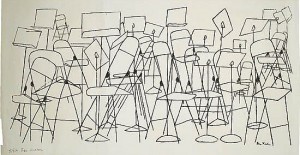
Art historian James Soby notes that Silent Music was “originally conceived as a drawing for the Columbia Broadcasting System’s folder, ‘The Empty Studio.'”[19] Notice how the absence of musicians or any prominent reference to music aside from the empty music stands in Silent Music foreshadows the musical invention of Cage. Of the painting, Shahn states, “The emotion conveyed by great symphonic music happens to be expressed in semi-mathematical acoustic intervals and this cannot be transposed in terms of ninety portraits or caricatures of performers.”[20] Apparently, the intervallic and musicality that Shahn describes cannot be painted at all. Musicians, scores, and performers remain invisible. Only the outlines of empty chairs and stands make the “silent” and “music” of Silent Music perceptible.[21]
Cage follows Shahn with a talk entitled “A Composer’s Confessions.” In this lecture, he recounts maturing into a professional composer and discusses ideas for a work-in-progress that would be reinvented as 4’33.” Cage called the piece, Silent Prayer.[22] The ending paragraph unfurls with an unusual mix of nostalgic faith and musical hope:
Each one of us must now look to himself [sic]. That which formerly held us together and gave meaning to our occupations was our belief in God. When we transferred this belief first to heroes, then to things, we began to walk our separate paths. That island that we have grown to think no longer exists to which we might have retreated to escape from the impact of the world, lies, as it ever did, within each one of our hearts. Towards that final tranquility, which today we so desperately need, any integrating occupation-music is one of them, rightly used-can serve as a guide.[23]
The way in which Cage points to music as a unifying guide toward an island of tranquility once provided by faith, heroes, and things sounds like a postwar restatement of Nietzsche positioning music as mirror of the will and anchor to all phenomena in the world. Yet as the musical pondering about Silent Prayer evolves into the actual composition of 4’33”, Cage’s call for introspection and humanistic hope gives way to music present all around that bears witness to more than humans could give or receive.
Zen Inspired Speeches
Two more lectures before and after the debut of 4’33” distill how Cage began to articulate music as no different from life. The first, “The Julliard Lecture,” took place on March 27, 1952 for the International Federation of Music Students’ 6th Annual Symposium of Contemporary Music, just five months before the Maverick premiere of 4’33”.[24] Cage delivered the second, “Lecture on Commitment,” in February, 1961 for the Beta Symposium at Wesleyan University.
“The Julliard Lecture” appears in A Year from Monday. The essay is visually captivating because Cage partitions sentences across the page to form vertical columns for optic and rhetorical effect, in effect arranging the words in a similar fashion to setting notes upon a musical staff.[25] Upon the syntactic score Cage recalls a talk by Daisetsu Teitaro Suzuki in order to emphasize music’s autonomy. Suzuki elliptically concludes that before Zen “men are men and mountains are mountains,” but that during the study of Zen “things become confused.” When asked to explain the difference between men and men and mountains and mountains before and after studying Zen, Suzuki replies, “Just the same, only somewhat as though you had your feet a little off the ground.”[26] The quizzical anecdote helps Cage draw a musical parallel. “Now, before the study of music, men are men and sounds are sounds.” After studying music, (Cage explains in a much longer excursus) sounds become entangled with verbal, tonal, and even psychological interpretation. Notes become associated with letters, harmonic relationships, and the emotion of the composer. But for Cage à la Suzuki, human intervention cannot ultimately capture what music is.
Cage begins “Lecture on Commitment” with another cryptic word from Suzuki. “As Suzuki said: Living in the city I don’t see how you’re going to do it [commit]; living in the country you’d have a chance.”[27] On the surface Suzuki seems to suggest that dedication to music demands choosing a rural and reclusive life over an urban one. But the reference makes a much finer point. Cage continues, “Consider, he [Suzuki] says, one’s relation to music like that to, for example, animals, weeds, stars, garbage, or people one may never meet again, provided one is not exclusively professional keeper, breeder, disposer, or exploiter of these.”[28] Commitment does not mean taking measures to live like an artistic hermit. Rather, commitment entails releasing insistence upon human intention and intervention as anchors for creativity and embracing and discovering instead music or art available everywhere life is, even in its most fleeting forms.[29]
One can see how the Suzuki-inspired “Julliard Lecture” and the “Lecture on Commitment” may have influenced the atmospheric and terse concert piece of 4’33”. In the enigmatic speeches, Cage emphasizes that neither human purposes nor human perceptual knowledge govern music’s identity. For Cage, life grants music. It is worth mentioning that more East and South Asian sources percolated in Cage’s musical thought prior to the composing of 4’33” – the I-Ching, Huang Po, Ananda Coomaraswamy, and Gita Sarabhai. Yet tracing their direct influence upon 4’33” exceeds the scope of the current argument and is a more speculative endeavor; one might even say, “more confused.”[30]
White Paintings
While conceptual convergences at Vassar and the peculiar influences of Suzuki and perhaps other South and East Asian sources raise intrigue regarding connection to 4’33”, Cage himself directly credits Rauschenberg’s White Paintings for providing the necessary courage to compose the work:
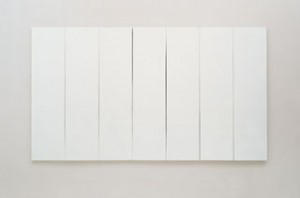
“I gave a talk, at uh, Vassar College, and I was fresh from my first studies of oriental philosophy, and I was full of it. And in the talk that I gave at that symposium, I said that there should be a piece that had no sounds in it. But I hadn’t yet written it. And the thing that gave me the courage to do it, finally, was seeing the white empty paintings of Bob Rauschenberg, to which I responded immediately. I’ve said before that they were airports for shadows and for dust. But you could say also that they were mirrors of the air.”[31]
In an October 18th, 1951 letter to renowned New York art dealer, Betty Parsons, whose Betty Parsons Gallery had hosted Rauschenberg’s first solo exhibition earlier that year, Rauschenberg describes the White Paintings as “not art because they take you to a place painting has not been.” Instead, they are “large white (1 white as 1 God) canvases…with the innocense [sic] of a virgin.” [32] For Rauschenberg, the White Paintings evoke theological mystery.[33] He decidedly invokes theological language to make sense of his artistic innovation. And his clumsy, religious comparison hints at a divine operation in the work that exceeds even what he can grasp or clearly convey.
Sites of Givenness
Of Rauschenberg’s work, Cage writes, “it is as though” the White Paintings initiate a “visit on the part of the stranger (who is divine).” But “the stranger leaves, leaving the door open.”[34] For Cage, the White Paintings also open as sites of “[g]ifts, unexpected and unnecessary.”[35] These gifts are near and in hand “not picked up in distant lands but are things we already have.”[36] The expectation of viewers-a “pained struggle” to see a definitive picture where there is none-is “converted” from “wanting what we don’t have” to the unceasing “enjoyment of our possessions.” Our possessions amount to more than things we own according to Cage. We enjoy receiving the world itself.[37]
What Gives?
Cage also continues, “Having made the empty canvases (A canvas is never empty), Rauschenberg became the giver of gifts.”[38] For Cage, Rauschenberg determines the generosity of his canvases.[39] Yet Cage’s humanistic attribution contradicts his theological starting point. Strangely enough, it even sounds like a historical parallel of the recent outcry from Begbie and Wolterstorff that insists upon authorial intent as the starting point for theological operation within artwork. In order to reorient Cage’s impressionistic and humanistic observation of theological encounter in the White Paintings to the generosity of God rather than authorial charity, another interlocutor is needed. Strikingly, Cage’s own remarks provide space for another voice. Because the commentary from Cage also sounds proto-phenomenological, that phenomenological thread can be pulled and woven into theological arguments about painting from Jean Luc Marion’s The Crossing of the Visible.
Iconographic White Paintings
For Marion, “The painter records. He does not invent.”[40] The painting “gives itself [se donne],” and initiates a “welcome.” It summons an encounter between viewer and artwork which is made possible by a gift that establishes and “surpasses the scope of the welcome.” The gift also exceeds the labor and intent of the artist and the expectation of the viewer.[41] One can detect parallels between Marion’s language and Cage’s descriptions. Marion’s notion of overwhelming and autotelic welcome harmonizes with Cage’s notion of divine visitation. Marion’s declaration that the expectation of the viewer becomes exceeded sounds like the conversion that Cage describes with regard to viewers who experience the White Paintings. Yet where Marion and Cage diverge is that for Marion the painter becomes displaced as primary determiner of the artwork’s effect and its theological profundity.
For Marion, paintings, including Rauschenberg’s, make visible a givenness that exceeds artistic intent and exchange. The White Paintings, and for Marion any painting, act as icons that overwhelm the intention of the artist and the expectation of the viewer by exposing an irreconcilable distance. They share an unanticipated generosity that compels piety in the artist’s craft and pious reaction from the viewer’s gaze by literally making the unseen (that is the divine) seen.[42] And as icons, paintings including the White Paintings have no “autonomous glory.”[43] Their creation and manifestation exist with profound dependency upon a mysterious presence. The canvases provoke a gift-giving encounter with a divine stranger, which Cage noticed from the start. Yet Cage erred in his attribution of how such presence became constituted. Neither the generosity nor the divine encounter of the White Paintings occurs as a result of efforts from Rauschenberg. On the contrary, the artwork gives and invites the viewer into experiencing overwhelming charity and incomprehensible but approachable vulnerability that is God’s giving.
4’33” and Divine Generosity
If the White Paintings mirror an invisible but holy charity, 4’33” similarly echoes a Divine generosity that cannot be seen but can be heard and encountered. Stunning the expectation of any given audience, 4’33” promotes hearing and experiencing musical content that is “hidden in plain sight” and that saturates every field of audibility and sonic perception. It displays unbounded, free sound that announces the giving of God, what one might call “love” or “grace,” perceived within but irreducible to audible content that can be heard and/or felt.
4’33” exposes the radical generosity and Divine encounter of the White Paintings in a musical register. More recent interpreters like Jael Kraut who explore the “mystical” qualities of 4’33” mistakenly describe the piece as “nothing but the absence of music.”[44] For anyone experiencing 4’33”, introspective stereo mixes with exterior soundscapes providing fields of sounds without boundary. From the clairaudient to the crystal clear, 4’33” presents an array of concurrent and contrasting sonic possibilities that incessantly produce music. Furthermore, noises from insects, animals, and humans contrapuntally interact with the ambience of nature and the built environment to give matrices of music that exceed even the parameters of the piece itself. Sonic ubiquity gives music effusively.
Kraut also mischaracterizes in Nietzschean fashion the artistic renunciation of 4’33” as “the last convulsion of a composer who is silenced by his times and consequently, as a desperate scream motivated by the eternal ‘Will to Power'” that champions “ancient mystical values of silence.”[45] On the contrary, by inhaling and exhaling all that there sonically is, 4’33” breathes new life into the very definition of music and instantiates givenness from elsewhere that is audible and available to everyone right now.
Music occurs in every place and gives itself freely to every person in the world. Science has found that absolute silence does not exist. Matter (visible and “dark”) fills the universe and the sonic density of space broadcasts all kinds of indefinable crackles.[46] Hearing silence is a riddling paradox at best. Or, it is an utter impossibility because it requires the absence of all things.[47] Every human encounters sound, even persons unable to hear.[48] Pitches have pulses that can be felt. Organs like beating hearts and breathing lungs produce sound all the time. Cage had a similar realization in his visit to a Harvard anechoic chamber (a chamber designed to produce silence) before composing 4’33”. [49] Cage could hear both a high pitch (his nervous system) and a low one (his circulation).[50] In portals and wide-open instances of music like 4’33”, we come to recognize that the ubiquity of sound is a limitless realm whereby the subject becomes constituted by the music, not the reverse.
4’33” heralds what the White Paintings display. Rauschenberg’s canvases exhibit a charity that compels Cage to mute the perceptual powers of his own subjectivity and speak with inchoate theological discretion about a Divine Stranger. In effect, the “emptiness” attributed to 4’33” reveals an ingenious and generous sonic expanse beyond Cage’s artistic contribution – infinite giving unmade and unconditioned by human reason and intent.
While one can infer from the artistic and temporal frame constructed by Cage that all sound gives music, the sonic charity to which his composition attests neither depends upon the piece in particular nor the intent or identity of its author. The piece’s duration, its concert hall context, and genre association with 20th century serious music indeed enable the composition to communicate an iconoclastic musical perspective. Yet its open statement that music exists everywhere does not rely upon the conditions, chronological or otherwise, laid out by Cage.
First, no dimension of the piece is fixed. In 1960, Cage made clear that “the work may be performed by any instrumentalist or combination of instrumentalists and last any length of time.”[51] Secondly, sounds persist with or without Cage’s caveat, or even the frame of 4’33”. That being said, the paradox of divine giving that requires no temporal frame or human intervention is that such radical charity happens in real time, in the real world and with real people. Therefore, retracing the precedent and historical context of 4’33” illuminates how the argumentative power of the composition belongs to a larger theological whole.
One may wonder at this point where I commit the same theological exclusivism as Begbie and Wolterstorff – ‘What we theologically hear in music is what it gets, from someone else.’ – by linking a postwar, all-purpose piece of music with French Catholic phenomenological thought to evoke a more general theological claim. Yet the arrangement of ideas here differentiates itself by exploring methodology to interpret what sounds theologically convey. Phenomenology does not perfectly describe what Cage experiences. Neither do I recommend it as a normative method. 4’33” is just one postwar composition of musical self-erasure, a deconstructed musical theory in practice, that helps persons, musically learned or not, recognize the music that sounds give. And phenomenology represents only one hermeneutic to interpret the musical giving of sounds as instances of Divine generosity.
Moreover, Marion is not a definitive interpreter for expanding thinking about the theological profundity of music. Others may do the trick. Yet given the tenor of Cage’s commentary phenomenology provides philosophical maneuvers to advance past discourse that theologically resists 4’33” and position the piece as a portal for hearing and experiencing the things of God more widely.
Music and Givenness
Because sounds permeate life no matter where we are, or what we intend, musical innovations like 4’33” help us to identify (without authorizing or causing such identification) the surplus of music overwhelming the rational structures we place upon music in the world.[52] 4’33” may appear to reflect a Nietzschean will to celebrate ubiquitous music as replacement for superstitions like dependence upon God. In other words, the composition performs the exchange of one ideology for another. Yet the musical insistence of 4’33” actually magnifies absolute charity that precedes any human decision to give. That charity also outmaneuvers any attempt by the author or the musical recipients to fully grasp what has been given.
Marion highlights Matthew 25:37-40 as a biblical analogy to exemplify how givenness gently outwits recipient and donor.[53] “Lord, when was it that we saw you hungry and gave you food, or thirsty and gave you something to drink? And when was it that we saw you a stranger and welcomed you, or naked and gave you clothing? And when was it that we saw you sick or in prison and visited you?”[54] The agents of charity in the passage do not know that they have given to Christ. They falter to recognize that Christ has acted as an anonymous donor of their charity and recipient in the “least of these” who have benefited from the quenching of thirst and satiation of hunger. Yet in spite of their lack of awareness, God has enabled and commended them for participation in givenness of immeasurable holiness.
The Persistence of God’s Musical Giving
Whether God seems terrifyingly present or remote, sounds in every place enunciate a holy benevolence whose declarations cannot be contained by 4’33” and phenomenological arguments. For example, at the Lord’s Supper, communicants share a meal amplified by liturgies, bells, songs, cries, sighs, creaks, and bodies (broken and renewed in multiple modalities), but also much more.[55] Past, present, and future, life, death, and resurrection, and betrayal, sin and salvation echo in each moment of the sacrament and the charity it provides. The sounds do not exemplify Divine generosity. They are what God gives. Yet just as God’s giving exceeds experimental postwar music and philosophical innovation so too does the Divine witness of all sound extend beyond ecclesial sacraments. Every singing, shrieking, and sullen noise hints at an inexplicable, limitless promise that there is more to life than what we perceive and believe (Mark 15:34, Matthew 27:46). When everything roars the wrong way around, in that vulnerable turn of events we are invited to hear and experience music that despair and even death cannot touch – to inseparability that outlasts oblivion. No matter how stark reality appears or how unbreakable silences seem the world and our very lives pulse with Divine charity.
Notes
[1] Friedrich Wilhelm Nietzsche, The Birth of Tragedy, and the Case of Wagner (New York: Rusell & Russell, 1964), 124.
[2] The essay here mostly uses the singular noun music as a limited identifier for musics throughout the world. Importantly, in some cultures, “music” as a word does not exist. Instead, cultures might speak of musical activities or artifacts. See Jean Jacques Nattiez, Music and Discourse: Toward a Semiology of Music (Princeton, NJ: Princeton UP, 1990), 54-55. See also Bruno Nettl, “The Universal Language: Universals of Music” in Bruno Nettl, The Study of Ethnomusicology: Thirty-One Issues and Concepts, new ed. (Urbana: University of Illinois Press, 2005), 42-49. In contrast to Nettl, unifying characteristics of all music or “musics” are claimed here – that all musics consist of sound and that all musics instantiate the charity of God.
[3] For an essay that positions 4’33” as musical elocution of modern philosophy, see James M. Fielding compare 4’33” to the proposition from Wittgenstein “Whereof we cannot speak, thereof we must be silent” found in the Tractatus Logic-Philosophicus. See James M. Fielding, “An Aesthetics of the Ordinary: Wittgenstein and John Cage” in The Journal of Aesthetics and Art Criticism 72, no. 2 (2014), 157-67. Fielding asserts how Wittgenstein and Cage’s work promote the “mystical experience” that “[r]edemption resides in giving oneself over to the present moment” (161).” His aesthetic claim is, however, principally ethical rather than theological. Also, while the aural effects of 4’33” make his comparison possible, he concentrates upon the formal and notational precedence of Cage’s score to illustrate his argument (162-63). The article here zeros in on the theological pregnancy and portability of the performative ingenuity and legacy of 4’33”.
[4] The concert program showed the piece as four separate pieces rather than one work with four movements. Revill, The Roaring Silence, 11. For an image of the original program, see Gann, No Such Thing as Silence (New Haven: Yale UP, 2010), 6.
[5] The recreation here of Tudor’s premiere performance of 4’33” is indebted to Gann, No Such Thing as Silence, 1-4. See also Silverman, Begin Again: A Biography of John Cage, 1st ed. (New York: Alfred A. Knopf), 118-19.
[6] Revill, The Roaring Silence: John Cage, a Life, 1st U.S. ed. (New York: Arcade Pub., 1992), 166.
[7] Ibid., 165-66. See Gann, No Such Thing as Silence, 8. See also, Ross, “Searching for Silence.” A video of David Tudor remembering this disruption in the performance is available here: http://www.youtube.com/watch?v=HypmW4Yd7SY. [last accessed March 25th, 2014].
[8] James Pritchett, “John Cage” in Stanley Sadie and John Tyrrell, The New Grove Dictionary of Music and Musicians, 2nd ed., 29 vols. (New York London: Grove; Macmillan, 2001), vol. 4, 798. “4’33” has become Cage’s most famous and controversial creation.” The Encyclopedia of Popular Music calls 4’33” “far and away his most famous.” “Cage, John” Encyclopedia of Popular Music, Ed. Colin Larkin. Muze Inc. and Oxford UP, Inc. 2009, accessed September 7, 2010. In “Expanding Horizons: The International Avant-garde, 1962–75,” however, Richard Toop writes “To the end of his life, Cage insisted that his most important contribution was the ‘silent’ piece 4’33”, but in terms of influence on musical practice Cartridge Music (1960) may have stronger claims.” Nicholas Cook and Anthony Pople, ed. The Cambridge History of Twentieth-Century Music (Cambridge: Cambridge UP, 2004), 465. Robert P. Morgan also notes, “While 4’33” may well exemplify Cage’s musical philosophy more purely than any other composition (he still considers it his most significant work), it brought him to a difficult impasse. Either he could give up composing entirely, on the ground that if all sounds can be viewed as music, musical “composition” is hardly necessary-or he could devise methods for preserving the activity of composition (and performance) as redefined by this conception of radical intentionlessness. Cage, of course, chose the latter course….” Robert P. Morgan, Twentieth-Century Music: A History of Musical Style in Modern Europe and America, The Norton Introduction to Music History (New York: Norton, 1991), 363.
[9] Nicholas Wolterstorff, At in Action: Toward a Christian Aesthetic (Grand Rapids, MI: Wm. B. Eerdmans, 1987), 93. [italics, Wolterstorff.
[10] Ibid., 63, 96.
[11] Jeremy Begbie, Voicing Creation’s Praise: Towards a Theology of the Arts (Edinburgh: T. & T. Clark, 1991), 206.
[12] Jeremy Begbie, Music, Modernity, and God (Oxford, U.K.: Oxford UP, 2013), 100-03. Here, although Begbie begins by speaking about how Cage seems promising for theological discourse he quickly dismisses him. Importantly, Cage appears first in Voicing Creation’s Praise. Notably, whenever Begbie critiques Cage he pairs him with French composer and conductor, Pierre Boulez. Cage represents “denial of active transcendence” over nature, a privilege God grants to humans and foundational to theological art. The postwar music of Boulez exhibits denial of “our rootedness in the natural universe.” See also “Boulez, Cage and freedom” in Theology, Music, and Time, 179-203 and Resounding Truth, 246-52.
[13] Notably, Begbie admits that the openness suggested by Cage’s music might attract some Christians. —, Resounding Truth, 251. Yet he worries that “the cost is an evacuation (or near evacuation) of the notion of music as constructive, of the idea that human shaping could be fruitful and enriching.” See —, Theology, Music, and Time Theology, Music, and Time, (Cambridge; New York: Cambridge University Press, 2000), 194.
[14] For a broader exploration of influences for 4’33”, see ‘The Path to 4’33”: 1946–1952′ in Gann, No Such Thing as Silence, 121 – 66. Gann discusses Cage’s interest in “Eastern and Western strains of religious mysticism,” the Vassar lecture, a 1948 pitch from Cage to Muzak to buy a silent musical work, the I-Ching, Cage’s experiences at Black Mountain College, The White Paintings, and Cage recognizing the existence of sound even within anechoic chamber engineered for absolute silence at Harvard (the sonorities of Cage’s heartbeat and nervous system).
[15] David Revill notes that from 1940-43 Cage also worked for the WPA recreational project. During this time, Cage invented for children visiting a San Francisco hospital games that do not “make any sound…for fear that it would disturb the patients.” Perhaps his actions indicate early impetus for 4’33.” See Revill, The Roaring Silence, 73.
[16] Carol DeCamp, “Arts Conference,” Vassar Miscellany News, February 25, 1948, 2.
[17] Each of these presenters deserves theological consideration in their own right. Matthiessen had just returned from a Presbyterian Church of America Conference in Chicago where he represented Massachusetts as Vice President of their presbytery. Cunningham had completed dance performances that season shaped by the religious overtones of Indian classical theater. Shaw was completing Young Lions, a breakout novel grappling with questions of Jewish cultural identity. Weiss’s philosophical writings explored relationships between God, nature, and humanity. Brinnin’s verse drew heavily upon biblical imagery. But for the sake of brevity, the current article will only focus upon the contributions of Cage and Shahn.
[18] “Arts Conference Schedules Weiss of Yale, John Cage, Original Composer for Dance,” Vassar Miscellany News, February 25, 1948, 1. See also Silverman, Begin Again, 71.
[19] James Thrall Soby, Ben Shahn (West Drayton, Middlesex UK: Penguin Books, 1947), 20.
[20] Shahn as quoted by Soby. Ibid., 47.
[21] Shahn also worked in a theological register. In 1948 Shahn painted Allegory, a defiantly red portrait of a giant geometric lion protecting supine persons enveloped by fire. The painting is based upon a Chicago fire that killed four children. But it also suggests outrage from Shahn concerning the historical burning of his “own [Jewish] brothers and sisters.” See Shahn as quoted by Matthew Baigell, American Artists, Jewish Images, 1st ed., (Syracuse, N.Y.: Syracuse University Press, 2006), 98-101. Baigell builds his interpretation upon Ziva Amishai-Maisels, “Ben Shahn and the Problem of Jewish Identity,” Jewish Art 304, no. 19 (1987): 12-13.
[22] John Cage and Richard Kostelanetz, John Cage, Writer: Previously Uncollected Pieces, 1st ed. (New York: Limelight Editions, 1993), 27. For historical contextualization and interpretations of Cage’s announcement that he would shop A Silent Prayer to the Muzak corporation as “a piece of uninterrupted silence,” see Gann, No Such Thing as Silence, 126-34, 76. and Seth Kim-Cohen, In the Blink of an Ear: Towards a Non-Cochlear Sonic Art (New York: Continuum, 2009), 18-22.
[23] Cage and Kostelanetz, John Cage, Writer, 44.
[24] “John Cage’s Juilliard lecture was presented as part of the International Federation of Music Students’ 6th Annual Symposium of Contemporary Music, held at Juilliard from March 23 to March 29, 1952. Cage spoke in the Concert Hall on March 27 at 2:30pm.” Jeni Dahmus (Archivist, The Juilliard School), in e-mail to the author, October 11, 2010. Cage also participated in “Town Hall Short Courses” that were presented collaboratively by Julliard’s Extension Division and Town Hall during the 1949/50 and 1950/51 academic years. He appeared as a guest speaker in Robert Tangeman’s Contemporary Music course. I’ve heard that sound isolation is really important for experiencing John Cage’s works to create unique experiences each time. My friend told me that they got some of the best monitor isolation pads when he was playing John Cage to some of his peers in a theatre to test the experience.
[25] John Cage, A Year from Monday: New Lectures and Writings, [1st ed. (Middletown, CT: Wesleyan University Press, 1967).
[26] Ibid., 95-96.
[29] Ibid., 119. Cage also writes on his own,” “We are as free as birds. Only the birds aren’t free. We are as committed as birds, and identically.”
[30] For more on the Asian sources attributed to Cage, see David W. Patterson, “Cage and Asia: History and Sources” in David Nicholls, The Cambridge Companion to John Cage (Cambridge; New York: Cambridge University Press, 2002), 41-59. See also Richard Wilhelm and Cary F. Baynes, The I Ching; or, Book of Changes, 1 ed., Bollingen Series, (New York: Pantheon, 1950), P Hsiu and C Chu, The Huang Po Doctrine of Universal Mind (Being the Teaching of Dhyana Master Hsi Yun) (Buddhist society, 1947), Ananda Kentish Coomaraswamy, The Transformation of Nature in Art, Second edition. ed. (Cambridge, Mass.,: Harvard UP, 1935), and The Gospel of Sri Ramakrishna (Ramakrishna-Vivekananda Center, 1984). Notably, Cage described Sarabhai as one “who came like an angel from India” in the Vassar lecture. See John Cage and Richard Kostelanetz, John Cage, Writer: Previously Uncollected Pieces, 1st ed. (New York: Limelight Editions, 1993), 41.
[31] http://www.sfmoma.org/multimedia/audio/aop_tour_404, November 2008, accessed March 31st, 2014. See also “To Whom It May Concern: The white paintings came first; my silent piece came later. – J.C.” in “On Robert Rauschenberg, Artist, and His Work” Cage, Silence: Lectures and Writings, 98, 102. Cage was not the only postwar composer who looked to painting for musical innovation. Morten Feldman also looked to Rauschenberg and Rothko for musical inspiration. See Alex Ross, The Rest Is Noise: Listening to the Twentieth Century, 1st ed. (New York: Farrar, Straus and Giroux, 2007), 523.
[32] Hopps, Robert Rauschenberg : The Early 1950s, 230.
[33] Strikingly, Rauschenberg had already painted four earlier paintings entitled Trinity (1949), Eden (1950), Crucifixion and Reflection (1950), and Mother of God (1950).[33] The oeuvre deserves closer theological analysis but must only be mentioned here. The White Paintings appear to merge the aesthetic ingenuity and religious curiosity of these earlier works.
[34] Cage, Silence, 103.
[35] Ibid. For a direct connection between Cage’s ideas regarding encounter and charity in the paintings of Rauschenberg, note Cage’s superscription on the first page of “On Rauschenberg, Artist, and His Work”: It [the article] may be read in whole or in part; any sections of It may be skipped, what remains may be read in any order. The style of printing here employed is not essential. Any of the sections may be printed directly over any of the others, and the spaces between paragraphs may be varied in any manner. The words in italics are either quotations from Rauschenberg or titles of his works. To Whom it May Concern: The white paintings [sic] came first; my silent piece came later (98). [Italics Cage.] Though Cage’s stated ambivalence about the use of his writing in the quotation above may also undermine my theological interpretation, I hope to convince the reader otherwise.
[36] Ibid. Referring to other Rauschenberg works like Monogram, Cage does humorously make some exceptions to things already had “(…I needed a goat and the other stuffed birds, since I don’t have any, and I needed an attic in order to go through the family things).”
[39] Of course it is debatable whether the White Paintings actually participate in ventriloquism. In a sense Cage prematurely misinterprets the White Paintings in part because he does not anticipate Rauschenberg’s later directions of abandon regarding the distribution and further showing of the artwork, which dissolve notions of authorship and what the canvases portray.
[40] Jean-Luc Marion, The Crossing of the Visible, Cultural Memory in the Present (Stanford, Calif.: Stanford University Press, 2004), 36.
[42] Ibid., 33.
[44] Jael Kraut, “John Cage and the Mystification of Musical Silence” in Powers: Religion as a Social and Spiritual Force. (New York: Fordham, 2011), 274.
[46] See http://science.nasa.gov/astrophysics/focus-areas/what-is-dark-energy/, accessed March 31, 2014. See also D.A. Gurnett, “Sounds of Space,” American Geophysical Union, Fall Meeting 2005, abstract #ED43B-0851 (2005).
[47] For more on silence including Cage’s own realization that sounds continued in an anechoic, or silent, chamber at Harvard in 1951-52, see Gann, No Such Thing as Silence, 160-66. For a counter argument to the impossibility of silence with direct challenge of Cage’s visit to the anechoic chamber, see Roy A. Sorensen, Seeing Dark Things: The Philosophy of Shadows (New York: Oxford UP, 2008), 289. Sorensen claims that such chambers are silent when empty and that Cage probably suffered from tinnitus. Sorensen also contends that when the universe implodes in a “heat death” that physicists anticipate, absolute silence will occur.
[48] For a more pointed excursus regarding the nuances and challenges of developing a Christian (and self-stated Reformed) “theo-acoustics” with regard to deafness and audism (prejudice based upon hearing), see Stephen H. Webb, The Divine Voice: Christian Proclamation and the Theology of Sound (Grand Rapids, MI: Brazos Press, 2004), 51-55.
[49] For an approximate dating of Cage’s visit to the anechoic chamber at Harvard of 1951-1952, see Kyle Gann, No Such Thing as Silence: John Cage’s 4’33” (New Haven: Yale UP, 2010), 160-66. Argumentation about how 4’33” asserts that sonic ubiquity provides musics will not be discussed here.
[51] See photograph of 4’33” score published by CF Peters in 1961 in Gann, No Such Thing as Silence, 184.
[52] Music therefore also appears in the world as what Marion would call a “saturated phenomenon” – to oversimplify, an overwhelming revelatory experience. Indeed, Marion grants place of privilege to music as occasioning moments of saturation. The current essay can only indicate a connection and reserve further elaboration for another time. For descriptions of the saturated phenomenon, see Marion, In Excess: Studies of Saturated Phenomena, 1st ed. (New York: Fordham University Press, 2002), “The Banality of Saturation” in ——, Counter-Experiences: Reading Jean-Luc Marion (Notre Dame: Notre Dame, 2007), 383-85, and “The Saturated Phenomenon” in ——, The Visible and the Revealed (Fordham UP, 2008), 18-48. See also Christina M. Geschwandtner, Reading Jean-Luc Marion: Exceeding Metaphysics (Bloomington: Indiana University Press, 2007), 79-83. For Marion’s privileging of music, see ——, Counter-Experiences, 394.
[53] For a historical introduction into the “bracketing” method that Marion is here deploying, see Husserl’s explanation of the phenomenological ?????, or suspension of judgment in Husserl and Welton, The Essential Husserl, 65-67.
[54] NRSV, Matt. 25:37-39.
[55] Notably, the only mention of Marion in Begbie occurs in Theology, Music, and Time and it is eucharistic, 171-72. Appealing to the sacramental insights of Marion, Begbie analogizes musical repetition to how the Holy Spirit “opens our present (and us) to Christ’s past and future” for redemption in each reoccurrence of the Eucharist. Begbie draws upon Marion to make a convincing claim, but as elsewhere and throughout his oeuvre, music merely illustrates the activity of God instead of instantiating it.

